Wurtsmith Air Force Base History
Airport History
Wurtsmith got its start in 1923 as Loud-Reames Aviation Field, a soft-surface landing site for Arm Air Corps aircraft from Selfridge Field. It was renamed Camp Skeel in 1924, for the World War I Pilot Captain Burt E. Skeel, and was used as an aerial gunnery range and for winter maneuvers 1924 through 1944 by the 1st Pursuit Group at Selfridge Army Air Base near Detroit. During those winter maneuvers the army pilots and mechanics battled snow squalls and bitter cold temperatures to get the engines of the plane started. Oil was heated in drums over open fires of pitchpine and then poured into the engines. Crews then worked fast to get the engines running before the oil congealed. No self-starters were available on those early planes so engines were cranked by hand by swinging the propellers. Aviation gasoline to refuel the planes was hauled across the ice-covered lake on a six-foot hand sled which held two barrels. After 1927 the field was also used for aerial gunnery practice.
World War II
Three 5000′ x 150′ hard-surface concrete runways aligned NE/SW, E/W and NW/SE were built in 1942 and the camp was renamed Oscoda Army Air Field. The airfield was placed under III Fighter Command jurisdiction on September 2 1942 and the 100th Base HQ and Air Base Squadron was activated at Oscoda AAF on October 31 1942. The mission of the field was an auxiliary airfield of Selfridge Army Air Base for the defense of Saulte Sainte Marie and the Straits of Mackinac. The airfield was declared excess by Third Air Force in December 1942 and turned over to Air Service Command and placed on standby status.
Third Air Force reactivated the field in March 1943 as a field for training black aviators. The 332d Fighter Group was moved from Selfridge AAB up to the primitive facilities due to racial tensions between the aviators and the local population in Detroit. Jurisdiction of the base was transferred back to First Air Force on August 14 1943. The group remained at Oscoda until the end of December training black aviators and once graduated, they would be deployed to Italy where they joined several black fighter squadrons under Twelfth Air Force.
Beginning in July 1944, with the closure of Blackstone Army Airfield, Virginia, it was used to train Free French Air Force (French: Forces Aeriennes Francaises Libres, FAFL) pilots under the 134th Army Air Forces Base Unit. On July 12 1944 the arrival of one French lieutenant and 34 enlisted flying students on July 17th followed shortly by the almost complete transfer of personnel from Blackstone AAF, started a new era of activity at the base. In three months, base personnel figures more than doubled. Under this new setup, the 13th AAF Base Unit (Fighter) consisted of four sections: Medical, Supply, Administrative and the French group.
A training program was set up that consisted of subjects designed to prepare personnel for shipment to combat zones. Subjects ranged from gas warfare to first aid, and classroom instructed was supplemented by field exhibits, movies, and lectures.
The Free French Air Force pilots also went through an intensive period of advanced aerial training, after which they were sent to the French Army Air Forces Staging Area at Bolling Field, Washington, D.C. and from there to a Free French Air Force reception center for assignment to operational squadrons engaged in combat. In the course of one three-month period during that year, more than 125 fliers received gunnery training, through the Gunairstructor, the Range Estimation Trainer, aid the Deflection Trainer. During the subsequent months the mission of the base was broadened even further, to include combat crew training. By October 1944, 93 French army personnel completed the required training.
On 12 April 1945 a bulletin was received from First Air Force re-designating Oscoda AAF as a sub-group of Selfridge, and directing that Oscoda be utilized in the future as a bombing and gunnery range by Selfridge Field. Training of the French pilots ended and most USAAF personnel were transferred out.
Continental Air Command
Jurisdiction of Oscoda AAF was transferred to Continental Air Command on 16 April 1945 and ConAC subsequently designated Oscoda as a sub-base Selfridge Field. It was placed in inactive status on 31 December 1945, and for the next several years, the station operated as a transient aircraft stopover.
The base was again reactivated as a primary installation on 20 February 1947, although it remained in a standby status by ConAC. In late 1950, an Air Defense Command Radar unit, the 754th Aircraft Control and Warning Squadron arrived at Oscoda while its permanent facilities at Port Austin Air Force Station were under construction. It moved out on 20 July 1951.
Air Defense Command
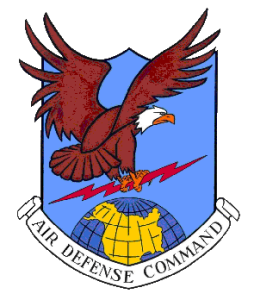
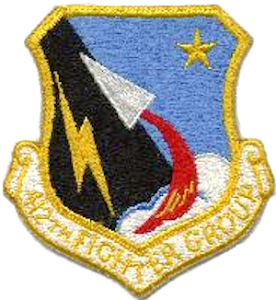
The base became a permanent installation on 1 January 1951 when the United States Air Force designated it as a fighter-interceptor training base for the Air Defense Command’s (ADC).
Much construction was necessary to bring the World War II training base up to postwar Air Force standards. In 1951 additional land surrounding the base was appropriated for military facilities and extended runways. A jet runway (6/24) was laid down along with accompanying taxiways, concrete block buildings and other support facilities to replace the temporary wooden World War II structures that were viewed as substandard for a permanent Air Force base.
The base was renamed Wurtsmith Air Force Base in 1953 after Michigan native Major General Paul Wurtsmith, who was killed when his TB-25J-27-NC Mitchell, 44-30227, crashed near Cold Mountain, North Carolina in September 1946.
Wurtsmith AFB was considered a vital Air Defense Command base, an alert-status military base equipped with interceptors ready 24/7 to respond to unknown aircraft picked up by Ground Control Radar stations in the Great Lakes region. Upon activation, Wurtsmith-based interceptors were directed to intercept unknown aircraft by ADC ground control Radars at Willow Run AFS (P-23); Selfridge AFB (P-20); Port Austin AFS (P-61); Alpena AFS (M-105); Empire AFS (P-34), and Sault Sainte Marie AFS (P-66), and the interceptors were under the command of the 56th Fighter-Interceptor Wing at Selfridge AFB, Eastern Air Defense Force, ADC.
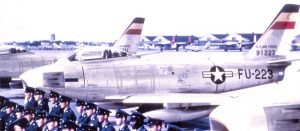

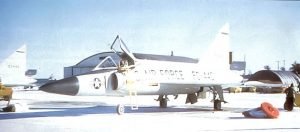
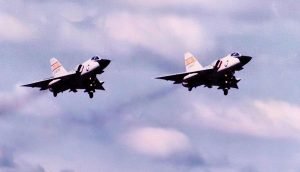
The initial interceptor squadron assigned to Wurtsmith was the 63d Fighter-Interceptor Squadron, assigned on 1 May 1951 and equipped with North American F-86A Sabres and was upgraded to the more-capable F-86F Sabre in December 1952.
On 6 February 1952, the 4706th Defense Wing at O’Hare International Airport, Illinois, replaced the 56th FIW as the Command and Control organization for Wurtsmith AFB. At that time, intercepts by the 63d FIS were directed by a manual direction center (P-23) at Willow Run AFS which received radar data from a wider series of search and height surveillance radars in the Great Lakes Area. In May 1954 the first true ADC-dedicated interceptor, the F-86D Sabre was received by the 63d FIS, and the highly capable Northrup F-89D Scorpion in January 1955. The squadron was moved to O’Hare International Airport, near Chicago on 18 August 1955 in an ADC reorganization.
With the reorganization, the 412th Fighter Group was activated at Wurtsmith under the 4708th Air Defense Wing at Selfridge AFB.
- The 445th Fighter-Interceptor Squadron was moved from Geiger Field, Washington equipped with F-89D Scorpions. The 445th FIS was upgraded to the new F-89G Scorpion in March 1956 (the first F-89G squadron in ADC); and upgraded to the F-89J in September 1957. It again converted to the new F-102 Delta Dagger supersonic interceptor in January 1960. It maintained alert with the F-102 until being inactivated on 30 September 1968 as part of the phase out of the Delta Dagger in favor of the newer F-106 Delta Dart.
- A second interceptor squadron, the 31st Fighter-Interceptor Squadron was moved from Larson AFB, Washington, to Wurtsmith on 8 June 1956. The 31st flew the F-102 Delta Dagger, however remained at the base only briefly, before being deployed to Elmendorf AFB, near Anchorage, Alaska, on 20 August 1957 to serve on Alaskan Air Command defense duty. The 31st FIS was replaced by the 18th Fighter-Interceptor Squadron on 20 August 1957, being moved from Ladd AFB, near Fairbanks, Alaska. The 18th also flew F-102s as the second FIS at Wurtsmith.
In 1958 a Semi Automatic Ground Environment (SAGE) Data Center (DC-06) was established at Custer AFS. The SAGE system was a network linking Air Force General Surveillance Radar stations into a centralized center for Air Defense, intended to provide early warning and response for a Soviet nuclear attack. The interceptors at Wurtsmith came under the command and control of DC-06 for direction and guidance to unknown aircraft within the region.
With the transfer of Wurtsmith to Strategic Air Command jurisdiction on 1 Apr 1960, ADC phased down its presence to a tenant organization. The 412th Fighter Group was inactivated on 1 April 1960. The 18th FIS was reassigned to the 478th Fighter Group at Grand Forks AFB, ND on 1 May 1960, leaving the 31st FIS as a single ADC interceptor squadron at the base. During the 1960s and early 1970s, ADC retained an alert posture on Wurtsmith with an air defense interceptor force for the Great Lakes area:
- The 445th FIS was inactivated on 30 September 1968 and retired its F-102s. It was replaced by the 75th Fighter-Interceptor Squadron (36th AD) with McDonnell F-101B Voodoos.
- The 94th Fighter-Interceptor Squadron (23d AD) replaced the 75th FIS which was transferred to Tactical Air Command (TAC) on 1 December 1969 with F-106 Delta Darts.
- With the transfer to TAC of the 94th FIS, it was replaced by the 2d Fighter-Interceptor Squadron (23d AD) on 1 July 1971 which took over the 94th FIS’s F-106s. The 2d FIS inactivated at Wurtsmith on 31 March 1973 as part of the draw-down of the Aerospace Defense Command jet interceptor force and ended the ADC presence at Wurtsmith.
Strategic Air Command Use
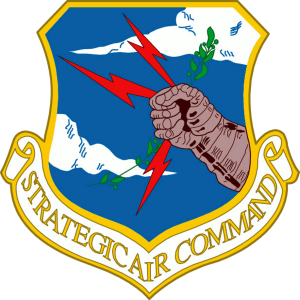
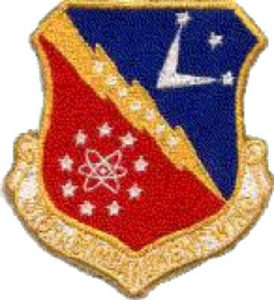
The Strategic Air Command’s 4026th Strategic Wing was activated at Wurtsmith on 1 August 1958. The 4026th SW was a B-52’s dispersal wing, a part of SAC’s plan to disperse its big bombers over a larger number of bases, thus making it more difficult for the Soviet Union to knock out the entire fleet with a surprise first strike. The 920th Refueling Group’s KC-135 Stratotankers were transferred to the 4026th from Turner AFB, Georgia in July 1960. It was inactivated on 9 January 1961.
SAC’s 40th Air Division was reactivated in July 1959 and assigned to Eighth Air Force with headquartered at Wurtsmith AFB. The Division was the parent unit of four SAC wings and advisor to three Aerial Reserve Force units. The Division’s mission was to supervise and monitor the operation of the 379th and 410th Bombardment Wings, the 305th Aerial Refueling Wing, the 351st Strategic Missile Wing, the 128th Aerial Refueling Group, and the 931st Aerial Refueling Group. SAC also began to extended the runway to 12,000 feet in 1959 to better accommodate the B-52. Along with the runway extension, a “Christmas Tree” alert pad area was constructed on the north side of the 24 runway end to accommodate 9 alert aircraft, and a “Mole Hole”, where alert crews would live on shifts ready to man the alert aircraft and take off within a few minute notice.
On 1 Apr 1960, jurisdiction of Wurtsmith was transferred from Air Defense Command to Strategic Air Command. The 379th Bombardment Wing became the Base Host Operating unit, being moved from Homestead AFB, Florida.
On 9 May 1961, the 524th Bombardment Squadron took delivery of its first new Boeing B-52H Stratofortress, the “State of Michigan.” The 920th Air Refueling Squadron had arrived on 15 July 1960 with KC-135 Stratotankers that would refuel them in mid-air. The wing’s B-52Hs were the latest, and fastest of the B-52s, the TF33 engines of the B-52H offered 30 percent more thrust than the J57s of the G-model, even when the J57s were using water injection. A maximum thrust of 17,100 pounds could be delivered, producing much better airfield performance and an extra margin of safety during heavyweight takeoffs. For the B-52H, the ground roll was about 500 feet less than that of the B-52G. The TF33 was also much more economical, offering a notable improvement in range. Combat radius of the B-52H was 4176 nautical miles with a 10,000 pound bomb load, as compared with only 3550 nautical miles for the B-52G.
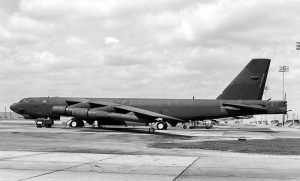
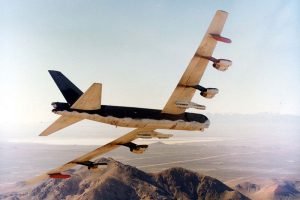
The 379th and its subordinate units’ mission was to operate at full readiness, and support activities included aircraft and vehicle maintenance, bombing crew and unit training, and air refueling support. The wing did not deploy bomber aircraft to Southeast Asia during the Vietnam War, as the B-52H was dedicated to strategic deterrence. However, the tanker aircraft and aircrews participated in the “Young Tiger” TDY effort, and the bomber aircrews went through RTU (Replacement Training Unit) training to fly B-52Ds out of Andersen AFB, Guam and U-Tapao RTAFB, Thailand and were active participants in many of the notable campaigns that took place in Southeast Asia such as Arc Light.
In 1977, the 379th exchanged their B-52Hs for the conventional bomb capable B-52G. In 1989, the Air Force selected Wurtsmith as one of seven bases that would house LGM-118A Peacekeeper ICBM Peacekeeper Rail Garrison. A Rail Garrison would address the survivability problem by which 25 trains, each with two missiles, would use the national railroad system to conceal themselves. It was intended that this system would become operational in late 1992, but budgetary constraints and the changing international situation led to it being scrapped.
In the early 1980s, Wurtsmith’s B-52Gs were modified to carry the Boeing AGM-86 Air-Launched Cruise Missile (ALCM). The ALCM was powered by a 600 lb.s.t. Williams F107-WR-100 turbofan, which is fed by an inlet which folds out on the top of the missile. The B-52G could carry six AGM-86Bs on each of the two underwing pylons.
Retirement of the B-52G began in the late 1980s in accordance with the Strategic Arms Reduction Treaty (START I), however the Gulf War of 1990–1991 resulted in a temporary delay in the inactivation of B-52G units. Wurtsmith-based B-52Gs were deployed to the 1708th Bombardment Wing (Provisional), King Abdul Aziz Air Base, Jeddah, Saudi Arabia (5 Aircraft) and the 801st Bombardment Wing (Provisional), (8 Aircraft). The planes arrived at dawn on the first day of the air war. One plane flew 29 missions out of Jeddah, the most of any bomber crew in the theater. The aircraft returned to Michigan in March 1991.
Closure
The dissolution of the Soviet Union further accelerated B-52G retirements and led the US Air Force to inactivate Strategic Air Command in 1992. As a result, nearly all KC-135 Stratotanker aircraft were transferred to the newly established Air Mobility Command (AMC), while all B-52 Stratofortresses, along with all B-1 Lancers, FB-111s, and the soon-to-be operational B-2 Spirits were transferred to the newly established Air Combat Command (ACC). As a result of this action, Wurtsmith was also transferred to ACC control.
Wurtsmith AFB closed on 30 June 1993 as a result of the 1991 Base Realignment and Closure (BRAC) process, which determined that the development of new weapons and long-range satellite surveillance systems rendered many installations unnecessary. On the morning of 15 December 1992, the last B-52G, AF Serial No. 57-6492, the “Old Crow Express,” was flown to Davis-Monthan Air Force Base for storage.
Credits and References
The information provided above was downloaded from Wikipedia, the free encyclopedia at http://en.wikipedia.org/wiki/Wurtsmith_Air_Force_Base. Text on Wikipedia is a collaborative work, and the efforts of individual contributors to a page are recorded in that page’s history, which is publicly viewable. Information on the authorship of images and other media, such as sound files, can be found by clicking on the image itself or the nearby information icon to display the file page, which includes the author and source, where appropriate, along with other information.
This article incorporates public domain material from websites or documents of the Air Force Historical Research Agency.
1. Jump up ^ About Oscoda-Wurtsmith Airport
2. Jump up ^ “Wurtsmith Air Force Base Superfund sites progress profile“. EPA. Retrieved 2010-02-21.
3. Jump up ^ “Wurtsmith Air Force Base Superfund site description“. EPA. Retrieved 2010-02-22.
· Maurer, Maurer. Air Force Combat Units of World War II. Washington, DC: U.S. Government Printing Office 1961 (republished 1983, Office of Air Force History, ISBN 0-912799-02-1).
· Ravenstein, Charles A. Air Force Combat Wings Lineage and Honors Histories 1947–1977. Maxwell Air Force Base, Alabama: Office of Air Force History 1984. ISBN 0-912799-12-9.
· Mueller, Robert (1989). Volume 1: Active Air Force Bases Within the United States of America on 17 September 1982. USAF Reference Series, Office of Air Force History, United States Air Force, Washington, D.C. ISBN 0-912799-53-6, ISBN 0-16-002261-4
· USAF Aerospace Defense Command publication, The Interceptor, January 1979 (Volume 21, Number 1).
